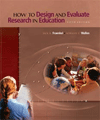 |  How to Design and Evaluate Research in Education, 5/e Jack R. Fraenkel,
San Francisco State University
Norman E. Wallen,
San Francisco State University
Experimental Research
Learning ObjectivesStudying this chapter should enable you to:
| Describe briefly the purpose of experimental research. |
 |  |  | | Describe the basic steps involved in conducting an experiment. |
 |  |  | | Describe the two ways in which experimental research differs from other forms of educational research. |
 |  |  | | Explain the difference between random assignment and random selection and the importance of each. |
 |  |  | | Explain what is meant by the phrase "manipulation of variables" and describe three ways in which such manipulation can occur. |
 |  |  | | Distinguish between examples of weak and strong experimental designs and draw diagrams of such designs. |
 |  |  | | Identify various threats to internal validity associated with different experimental designs. |
 |  |  | | Explain three ways in which various threats to internal validity in experimental research can be controlled. |
 |  |  | | Explain how matching can be used to equate groups in experimental studies. |
 |  |  | | Describe briefly the purpose of factorial and counterbalanced designs and draw diagrams of such designs. |
 |  |  | | Describe briefly the purpose of a time-series design and draw a diagram of this design |
 |  |  | | Describe briefly how to assess probably threats to internal validity in an experimental study |
 |  |  | | Recognize an experimental study when you see one in the literature |
|



 2003 McGraw-Hill Higher Education
2003 McGraw-Hill Higher Education